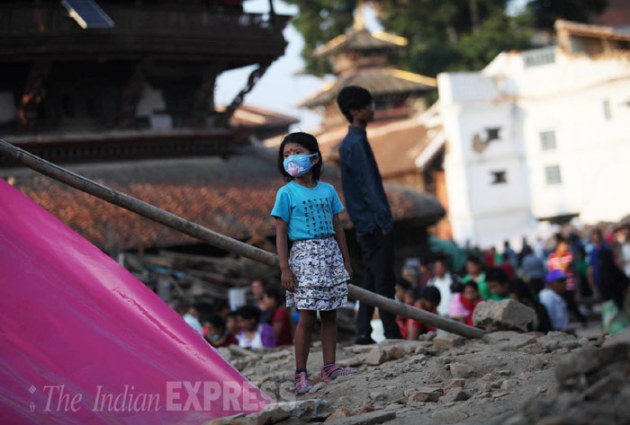One quake after the other, Nepal continues to find itself on shaky ground
The two earthquakes in Nepal are embedded in every mind, in every conversation.
 1 / 13
1 / 13A liitle girl wears mask in a relief camp set in Kathmandu, Nepal. After the devastating April 25 earthquake, that swallowed up parts of the city, many public service announcements were made, asking people to wear masks. (Source: Express photo by Tashi Tobgyal)
You’ve Read Your Free Stories For NowSign up and keep reading more stories that matter to you.Already have an account? Sign InThis story requires a subscriptionSelect a plan and use IE10 code to get 10% extra offAlready a subscriber? Sign inThis story requires a subscriptionSelect a plan and use IE10 code to get 10% extra offThis content is exclusive for our subscribers.Subscribe now to get unlimited access to The Indian Express exclusive and premium stories.Already a subscriber? Sign In- 2 / 13
Those who survived the deadly earthquake were told to protect themselves from the dust. They wore the masks for days but slowly, as they began to rebuild their lives and their faith, the masks started coming off. But, the major aftershock on Tuesday reinstilled fear among the people and the masks reappeared. (Source: Express photo by Tashi Tobgyal)
- 3 / 13
On Thursday, Prime Minister Sushil Koirala said, “After the first quake, we were not prepared for a second one so big,” after arriving in Charikot. Charikot, the isolated district was hit hardest by Tuesday’s 7.3 magnitude quake, in which at least 96 people were killed and more than 2,300 were injured. (Source: Express photo by Tashi Tobgyal)
- 4 / 13
PM said the coming monsoon rains now loomed large, with hundreds of thousands of people left homeless. “We need tents. Our people need shelter. With the rainy season, it will be difficult for people to survive in the open,” he said. (Source: Express photo by Tashi Tobgyal)
- 5 / 13
A traffic constable, Lakshman Attri, who was directing traffic on a near empty road said, “I have been told to act like it is a normal day. People have to move on, and it is our job to restore a sense of normalcy,” Attri said. (Source: Express photo by Tashi Tobgyal)
- 6 / 13
“We had reopened our clothes shop last week, but when the second big earthquake came, we shut it again. If two earthquakes can happen, why can’t three? I sit outside my shop to protect it from thieves, but I will not go inside. I have been pulling out bodies for two weeks, and I don’t want to be one of them. We stay in the park at night,” said Ram Kumar Rai, sitting outside his apparel store in Durbar Square. (Source: Express photo by Tashi Tobgyal)
- 7 / 13
There is also a shortage of tarps and tents in the Nepalese capital, Kathmandu, with some people even using cardboard boxes as temporary shelters. “We have nowhere to go. This is our home for now. We had just moved back into our rented rooms and again the earthquakes are back,” Raj Kumar, a carpenter who was sharing a small tent with two other families. (Source: Express photo by Tashi Tobgyal)
- 8 / 13
Amid the tension, everyone is trying to keep the morale up. In front of Durbar Square and Basantpur Temple complex, Laxminarayan Shilpakar waves a massive Nepal flag, asking people to keep the faith. (Source: Express photo by Tashi Tobgyal)
- 9 / 13
Laxminarayan Shilpakar waving the national flag from atop one of the damaged monument at Durbar Square in Kathmandu, Nepal. (Source: Express photo by Tashi Tobgyal)
- 10 / 13
The deadly earthquake has not only shaken the country and killed over 8,000 people, it has shaken the faith among the people too. Many temples in the country crumbled after the quake, as people try to set tents among the courtyards they pick a spot that is right in the middle of a clearing, at a safe distance from any structure. Even when among the gods, their faith is shaken. (Source: Express photo by Tashi Tobgyal)
- 11 / 13
Around 10 km south of Kathmandu, Khokana village in Lalitpur district sat above a hill like a time capsule with its age-old traditions, rituals and buildings around a 12th century temple — that was until the earthquake hit Nepal on April 25. Now, like several heritage sites, the village, known as the “living museum”, is just another pile of crumbled heritage. Yet people continue to believe and offer their prayers, praying to avert such deadly incidents. (Source: Express photo by Tashi Tobgyal)
- 12 / 13
More than two weeks after the 7.8 magnitude earthquake devastated Nepal, the streets of its capital can be misleading. Most buildings that were damaged now have wooden poles supporting them, and are barricaded from the outside, often looking like any other structure that is under construction. (Source: Express photo by Tashi Tobgyal)
- 13 / 13
Beyond colossal loss of human lives, if there is anything perhaps equally overwhelming in Nepal’s earthquake tragedy, it is the monumental damage the country’s iconic heritage has suffered due to the calamity. The powerful temblor practically levelled the nation’s tangible cultural history, robbing it of its architectural jewels, including the landmark Dharhara Tower, and Durbar Squares. (Source: Express photo by Tashi Tobgyal)